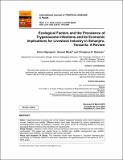| dc.description.abstract | Aims: Trypanosomosis is among one of the tropical neglected diseases which have impacted on human, livestock and wildlife. Different factors have been discussed by various researchers but ecological factors being considered in nutshell. This paper aimed at reviewing details on how the ecological factors influence the prevalence of trypanosome.
Study Design: Literature review where various literatures have been reviewed and the information synthesized. This paper has placed focus on: habitat type, wildlife management type, wildlife abundance and diversity, fire incidence and human activities.
Place and Duration of Study: This literature review work focused in Tanzania mainland and specifically on Simanjiro district for economic implication of trypanosomiasis for the period of 2011-2013 years.
Methodology: Literature Searching was done using key words in the following search engines Research gate, (https://www.researchgate.net), Google scholar, (https://scholar.google.com/), and PubMed. Manual search in printed documents were done in reports from government, poster, proceedings and publications which were not available in the internet.
Results: Variation of habitat types was observed to have impacts on spatial and temporal distribution of various tsetse flies and wildlife species which are vector and reservoirs of the diseases respectively. Incidence of fire affected the distribution of tsetse flies, wildlife and prevalence of trypanosome. For the interval of three years (2011-2013) a loss of more than 1million USD associated with trypanosomiasis is estimated in Simanjiro district. More money is used by pastoralists in treatment of animals than in spraying pesticides.
Conclusion: It is recommended that, more work to be done on the impact of ecological factors on trypanosomiasis. Also more effort is required in controlling the disease through collaboration of different stakeholders such as livestock officers, ecologists, veterinarians and other relevant agencies. | en_US |

